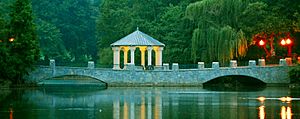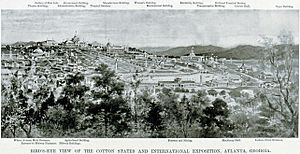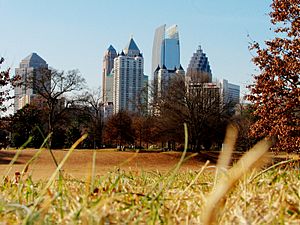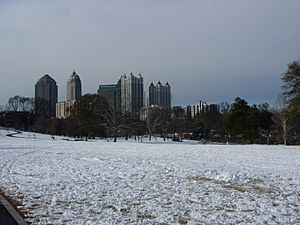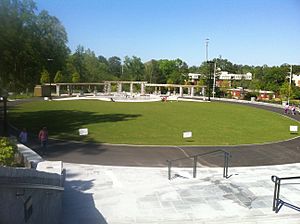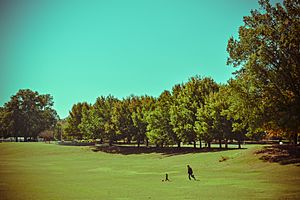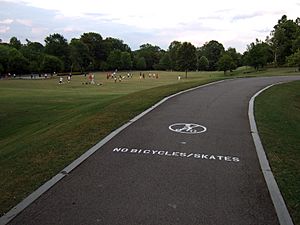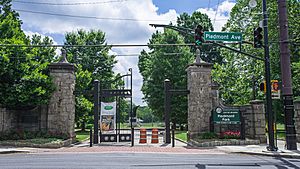Piedmont Park facts for kids
Quick facts for kids Piedmont Park |
|
|---|---|
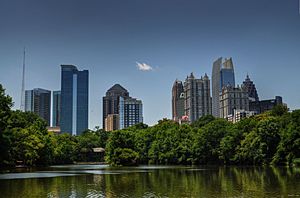
Piedmont Park's Lake Clara Meer with Midtown skyline in the background
|
|
| Type | Municipal |
| Location | Atlanta, Georgia |
| Area | 189 acres (76 ha) |
| Created | 1895 |
| Open | All year |

1887 Piedmont Expo
|
|
| Architect | Joseph Forsyth Johnson; John Charles Olmsted; Frederick Law Olmsted, Jr. |
| NRHP reference No. | 76000629 |
| Added to NRHP | May 13, 1976 |
Piedmont Park is a large city park in Atlanta, Georgia. It is located about 1 mile (1.6 km) northeast of Downtown. The park sits between the Midtown and Virginia Highland neighborhoods.
The land was first owned by Dr. Benjamin Walker. He used it as a large farm and home outside the city. In 1887, he sold the land to the Gentlemen's Driving Club. This club, later called the Piedmont Driving Club, wanted a special place for horse racing. The club worked with the Piedmont Exposition Company, led by Charles A. Collier. They used the land for big fairs and events. This is how the park got its name.
The park was first designed by Joseph Forsyth Johnson. It hosted two major events in the late 1800s. The Piedmont Exposition opened in October 1887. It was a big success. This led to the even larger Cotton States and International Exposition in 1895. Both events showed how much the region had grown after the Civil War.
Later, in the early 1900s, a new plan for the park began. This was called the Olmsted plan. It was created by the sons of Frederick Law Olmsted, who designed New York's Central Park. This plan added beautiful paths and connected Piedmont Park to the nearby Ansley Park system.
Over the years, the park has also been a sports hub for Atlanta. The city's first professional baseball team, the Atlanta Crackers, played there from 1902 to 1904. Important college sports games also happened here. This included the University of Georgia versus Georgia Tech baseball rivalry. Also, the Georgia versus Auburn football game, known as the "Deep South's Oldest Rivalry", started here.
Many improvements have been made to the park over time. These include picnic areas, tennis courts, the Lake Clara Meer dock, a visitor's center, and playgrounds. In 2008, work began on a 53-acre (21 ha) expansion. In 2011, Mayor Kasim Reed opened the first part of this big expansion. More areas in the far north of the park are still being developed.
Contents
Park History: How it Began
Atlanta grew very quickly in the years before Piedmont Park was created. From 1860 to 1890, the number of people living in the city jumped from about 9,500 to over 65,000. During these years, many schools and colleges opened. These included Morehouse College (1867) and Georgia School of Technology (1885).
Who Owned the Land?
The land that became Piedmont Park was bought by Benjamin Walker in the 1830s. He bought the 189 acres (76 ha) from a man who had won the land in a lottery. Walker farmed the land until 1887. Then, he sold it to the Gentlemen's Driving Club. This club is now known as the Piedmont Driving Club. They wanted to create a special club and race track for horse lovers.
The driving club made a deal with the Piedmont Exposition Company. This company used the land around the track for big public events. Charles A. Collier, a well-known Atlanta businessman, was the president of the company. Soon after, a main building, grandstands, and a clubhouse were built for the race track.
The 1887 Piedmont Exposition
The first big event at Piedmont Park was the Piedmont Exposition of 1887. It opened on October 10. The main building for the Exposition was very large. It was 570 feet (170 m) long and 126 feet (38 m) wide. On the first day, 20,000 people came to visit.
Important people like President Grover Cleveland and his wife, Frances Folsom, attended. Over 50,000 people came to hear President Cleveland speak. When the Exposition ended, leaders said it helped Atlanta become known as a great place to visit and do business.
The "Deep South's Oldest Rivalry"
Five years later, Piedmont Park hosted a famous football game. This game started the "Deep South's Oldest Rivalry". It was between Auburn University and the University of Georgia. Auburn won the game 10–0.
The 1895 Cotton States Exposition
In 1894, the Piedmont Exposition Company offered to sell the park land to the city of Atlanta. But the mayor said no. So, the park stayed private for another ten years.
The Cotton States and International Exposition opened for 100 days in 1895. It attracted visitors from across the U.S. and 13 other countries. Over $2 million was spent to get Piedmont Park ready. The government spent $250,000 on a special building. Many states and countries also built their own displays.
For the fair, the Tropical Gardens were created. These are now the Atlanta Botanical Garden. Lake Clara Meer, which was a small pond, was made much larger. Today, only the stone walls around the park remain from the huge main building. Most buildings from the fair were taken apart. Their granite was sold to help pay off the city's debt.
Booker T. Washington gave his famous Atlanta Exposition Speech at this event. It is considered one of the most important speeches in American history.
Fun attractions at the fair included Buffalo Bill's Wild West Show. The Liberty Bell was also on display. People also saw the first public showing of a motion picture projector. It was called the Phantoscope.
After the Exposition, the park remained very popular. It helped the area around it grow. More streetcar lines were added to make it easier to get to the park.
Early Atlanta Baseball
In March 1898, the park's baseball fields were finished. On April 16, 1898, the first baseball game between Georgia and Georgia Tech was played here. From 1902 to 1904, the Atlanta Crackers, Atlanta's first professional baseball team, played in Piedmont Park. They later moved to a stadium on Ponce de Leon Avenue.
The Olmsted Plan for Park Design
In 1904, the park changed a lot. The city of Atlanta bought the park for $98,000. This made Piedmont Park officially part of Atlanta.
In 1909, the sons of Frederick Law Olmsted were asked to design a new plan for the park. Frederick Law Olmsted was famous for designing Central Park in New York. His sons, Carey and Frederick, Jr., created a plan for Piedmont Park.
In 1910, they suggested a 5-mile (8.0 km) scenic path and roads. These would connect Piedmont Park to the streets of Ansley Park. This connection was a success, and the two parks became known as Twin Parks. Even though the full plan was never built, it greatly influenced how the area around the park developed.
Park Growth in the 1900s
The park's first public bathhouse opened in 1911. People could swim in the lake until 1973. That year, the city opened a swimming pool in the park instead. Also in 1911, the Peace Monument was placed in the park.
In 1913, seven clay tennis courts were built. Eight more courts were added in 1914 because so many people wanted to play. The Sidney Lanier Monument was also placed in the park that year.
Other important additions include the bandstand, built in 1915. A picnic shelter was built in 1936. The Pioneer Women memorial was added in 1938. The Noguchi Playscapes, a unique playground, was finished in 1976. It was designed by the famous artist Isamu Noguchi. In 2002, a special dog park was opened.
The Playscapes playground was fixed up in 2005. Workers made sure it met safety rules and restored its original bright colors.
Park Expansion in the 2010s
About 50 acres (20 ha) in the northwest part of the park were still woodlands in the early 2000s. In 2007, a plan was made to expand the park. This plan included new green spaces, walking trails, gardens, and playgrounds. It also added a skate park and athletic fields. The project was expected to cost $72 million.
On April 23, 2008, a special ceremony was held to start the 53-acre (21 ha) expansion. The pool and bathhouse were part of a big renovation. This renovation cost about $7.8 million and finished in 2009. It made the pool area more accessible and added fun features like bubblers and fountains. A new area with a Bocce ball court opened in 2010.
On April 12, 2011, Mayor Kasim Reed opened the first part of this major expansion. New areas included two large plazas called "The Greensward" and "The Promenade". The Promenade has an interactive "Legacy Fountain". Also opened were the "Lower Meadow", "Six Springs Wetlands", and a much larger dog park.
Construction continued in early 2013 on areas in the far north of the park. These new sections include "The Northwoods", "Piedmont Commons", and "Piedmont Gardens". New entrances to the park are also being added.
Piedmont Park Conservancy: Helping the Park Grow
The Piedmont Park Conservancy is a non-profit group. It helps improve the park and takes care of most of its daily upkeep and safety. The Conservancy started in 1989. Its goal was to make the park better because it was getting run down.
Since then, the Conservancy has raised and invested $66 million. This money has helped restore and improve Piedmont Park. Thanks to their work, it is now the most visited green space in Atlanta.
Fun Things to Do and See
Outdoor Activities
Piedmont Park has many miles of paved paths. These are great for walking, running, biking, and inline skating. You can rent bikes and skates from Skate Escape, which is across from the park's 12th Street entrance. On weekend afternoons, skateboarders and inline skaters often use the open paved area near the 12th Street entrance.
The park has picnic shelters east of the north soccer field. There are also many picnic tables and benches. Many people like to picnic on the large grassy areas. There are 22 grills throughout the park for cooking. You cannot bring your own portable grills.
The Noguchi "Playscape" is near the 12th Street Gate. This playground has cool, modern shapes. It includes a tall swing set, a slide, a sand pit, and a climbing dome. Everything is made with bright, exciting colors.
Another playground in the park is Mayor's Grove. It was designed to be very accessible for all kids. It has many interactive play features.
Sports and Games
Piedmont Park is a popular spot for organized sports. The Sharon E. Lester Tennis Center has 12 lighted hard courts. It offers leagues, lessons, and supplies.
The Active Oval has two softball fields, two soccer fields, and two beach volleyball courts. A dirt running path goes around them. Kickball leagues also use the softball fields.
The park's swimming center reopened in the summer of 2009 after being renovated.
Fishing and Lake Clara Meer
The lake is in the southeast part of the park. You can fish in the lake. It has fish like large mouth bass, crappie, bream, and catfish. In 2002, the lake was updated. A new bridge was added, connecting two parts of the lake. Three fishing piers were also built around the lake.
The Clara Meer Dock is at the west side of the lake. The historic Visitor Center building is just above the dock. The Clara Meer Dock is often used for wedding ceremonies. You can rent the dock and the Visitor's Center. The Visitor's Center has a beautiful painted mural called "A Day at the Park."
Dogs in the Park
Dogs are allowed in Piedmont Park most of the time. They must be on leashes 6 feet (1.8 m) or shorter for safety. Owners must clean up after their dogs. The park has stations with plastic bags to help with this. Some water fountains also have a low basin for dogs to drink from.
North of the Park Road entrance bridge are two fenced-in Dog Parks. These parks are about three acres (1.2 ha) where friendly dogs can play off-leash. New, much larger parks for small and large dogs opened in April 2011.
The Piedmont Park Conservancy helps take care of the dog parks.
Special Events and Festivals
Piedmont Park is a very important place for Atlanta's Midtown community. Many yearly events and festivals happen here. These include the Atlanta Pride Festival, the Atlanta Jazz Festival, the Atlanta Dogwood Festival, and Music Midtown. A summer movie series called Screen on the Green also plays films in the park.
On weekends and holidays, the park is full of music, sports, and fun activities. In 2004, the Georgia Shakespeare Festival started free performances called "Shake on the Lake." The Allman Brothers Band and Dave Matthews Band played a concert in 2007 to help raise money for the park's expansion. Sir Paul McCartney performed in 2009. The Eagles played in 2010. In 2011, Music Midtown returned to the park with headliners like Coldplay.
Park Schedule
The park is open every day from 6:00 AM to 11:00 PM.
Images for kids



